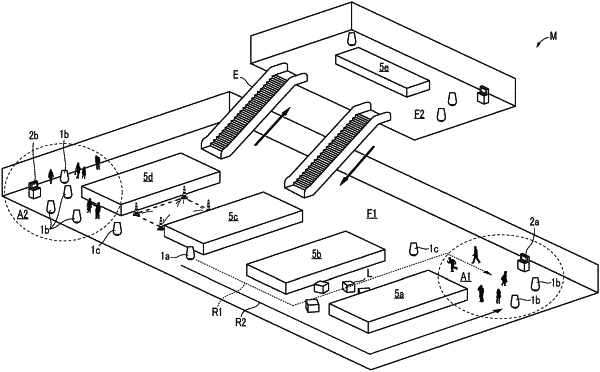| CPC G05D 1/0289 (2013.01) [B25J 5/00 (2013.01)] | 6 Claims |

|
1. A robot guidance system, comprising:
a plurality of autonomous mobile robots which are driven by an internal battery, and in a state of not guiding a user, stand by at one of a plurality of waiting areas, and when a destination of the user is recognized, move from the waiting area to guide the user to the destination;
a reception apparatus which is provided separately from the plurality of autonomous mobile robots and recognizes the destination;
a robot management unit which recognizes a state of each of the plurality of autonomous mobile robots and manages availability of each of the plurality of autonomous mobile robots based on the recognized destination and the recognized state;
a movement characteristic storage section which stores a movement characteristic that is a characteristic including a remaining battery charge amount of each of the plurality of autonomous mobile robots;
a robot selection section which selects at least one of the plurality of autonomous mobile robots as an autonomous mobile robot to guide the user; and
a waiting area determination section which determines, among the plurality of waiting areas, a waiting area where each of the plurality of autonomous mobile robots is caused to stand by,
wherein
the robot selection section selects at least one of the plurality of autonomous mobile robots standing by in a waiting area nearest to the reception apparatus as the autonomous mobile robot to guide the user, based on a distance to the destination recognized by the reception apparatus, the remaining battery charge amount of each of the plurality of autonomous mobile robots, and a distance between the destination and a waiting area nearest to the destination among the plurality of waiting areas,
the robot selection section selects the autonomous mobile robot with a smallest remaining battery amount that exceeds an amount required to move to the waiting area nearest to the destination after guiding the user to the destination among the plurality of autonomous mobile robots as the autonomous mobile robot to guide the user, and
when the robot selection section determines that the plurality of autonomous mobile robots standing by in the waiting area nearest to the reception apparatus have an insufficient remaining battery amount to complete travel to the waiting area nearest to the destination after guiding the user to the destination, the robot selection section expands selection of the autonomous mobile robot to the plurality of autonomous mobile robots standing by at waiting areas of the plurality of waiting areas other than the waiting area nearest to the reception apparatus.
|